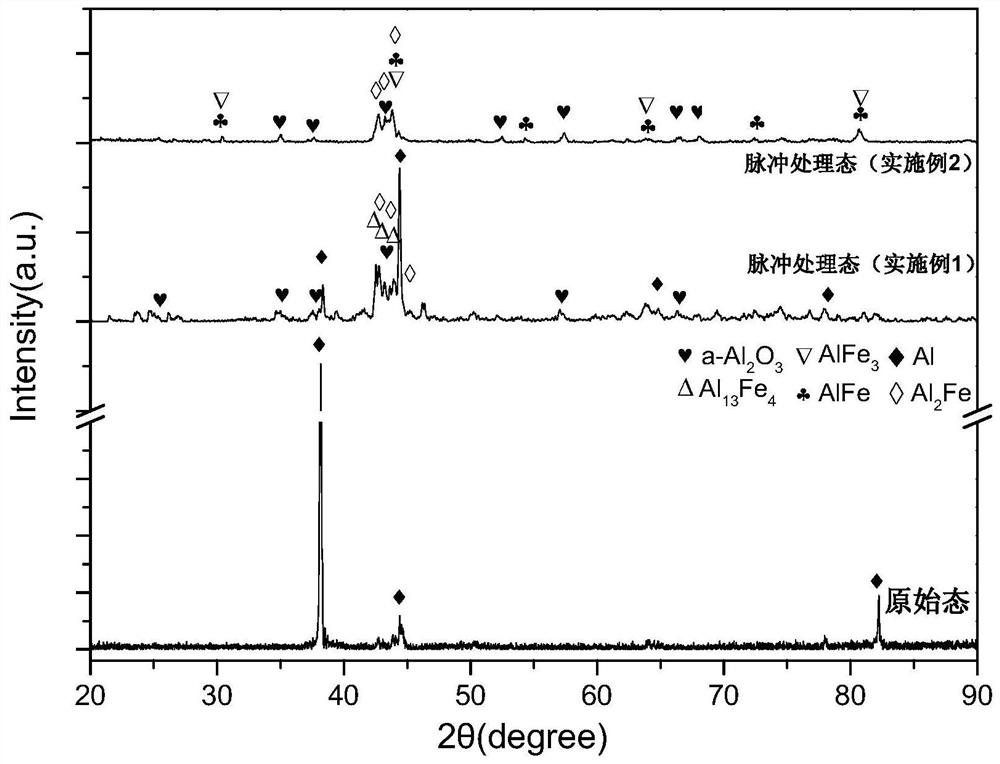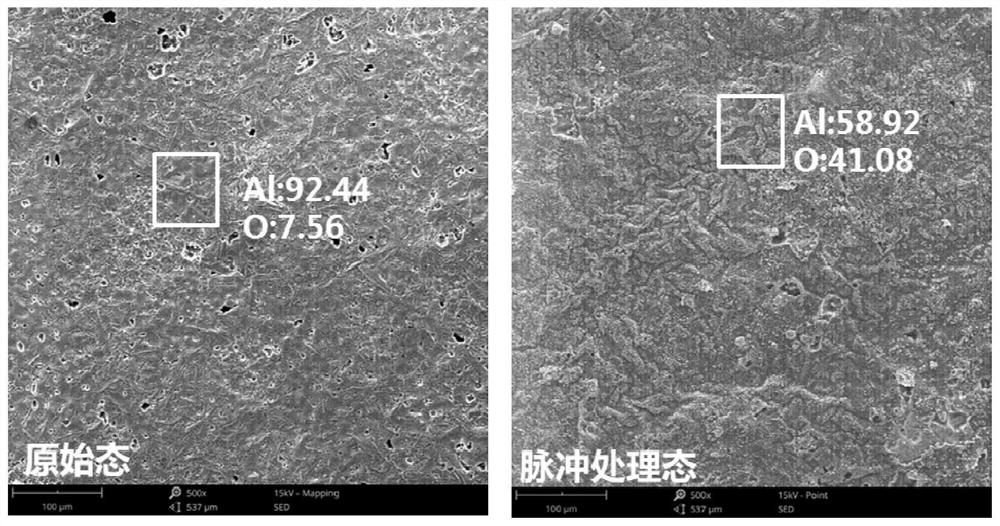A method for rapidly preparing aluminum oxide on the surface of 316l stainless steel aluminide anti-tritium coating
A stainless steel and aluminide technology, which is applied in the field of rapid preparation of Al2O3 on the surface of 316L stainless steel aluminide tritium-resistant coating, can solve the problems of matrix tissue damage, mechanical properties, reduction, and long processing time, and achieve low processing temperature, high efficiency, and easy operation. simple effect
- Summary
- Abstract
- Description
- Claims
- Application Information
AI Technical Summary
Problems solved by technology
Method used
Image
Examples
Embodiment 1
[0020] In this embodiment, pulse current treatment is performed on strip-shaped aluminum-dipping coated 316L stainless steel. Specific steps are as follows:
[0021] Step 1: Prepare pulsed samples. Take an aluminum-coated 316L stainless steel sample with a sample size of 30mm×10mm×2.2mm (immerse in a 680°C molten immersion aluminum solution for 10 minutes), and use an ultrasonic device to clean the sample in alcohol for 30 minutes to ensure that the sample is clean. Good contact with pulse electrode.
[0022] The second step: determine the pulse processing parameters and perform pulse processing. Set the parameter range of the pulse current, and determine the pulse current parameter as 31000Hz, 3.5μs, 12.7A / mm 2 , the action time is 5min, and the Joule heating temperature rise caused by the electric pulse is about 950°C. Fix the sample at the output end of the pulse power supply with a fixture, and conduct pulse current treatment on it at room temperature.
[0023] Step 3...
Embodiment 2
[0025]In this embodiment, pulse current treatment is performed on tubular aluminum-dipped 316L stainless steel. Specific steps are as follows:
[0026] Step 1: Prepare pulsed samples. Take an aluminum-coated 316L stainless steel sample with an inner diameter of 16.8mm, an outer diameter of 20.6mm, and a length of 40mm (immerse in a 750°C molten immersion aluminum bath for 8 minutes), and use an ultrasonic device to clean the sample in alcohol 30min to ensure that the sample is clean and in good contact with the pulse electrode.
[0027] The second step: determine the pulse processing parameters and perform pulse processing. Set the parameter range of the pulse current, and determine the pulse current parameter as 31000Hz, 3.5μs, 14A / mm 2 , the action time is 5min, and the Joule heating temperature rise caused by the electric pulse is about 1100°C. Fix the sample at the output end of the pulse power supply with a fixture, and conduct pulse current treatment on it at room te...
Embodiment 3
[0030] In this example, pulse current treatment is performed on tubular aluminized 316L stainless steel. Specific steps are as follows:
[0031] Step 1: Prepare pulsed samples. Take an aluminized coated 316L stainless steel sample with an inner diameter of 16.8mm, an outer diameter of 20.6mm, and a length of 40mm. Use an ultrasonic device to clean the sample in alcohol for 30 minutes to ensure that the sample is clean and can be in good contact with the pulse electrode.
[0032] The second step: determine the pulse processing parameters and perform pulse processing. Set the parameter range of the pulse current, and determine the pulse current parameter as 32000Hz, 3.5μs, 10.5A / mm 2 , the action time is 60min, and the Joule heating temperature rise caused by the electric pulse is about 900°C. Fix the sample at the output end of the pulse power supply with a fixture, and conduct pulse current treatment on it at room temperature.
[0033] Step 3: Carry out XRD detection on th...
PUM
| Property | Measurement | Unit |
|---|---|---|
| current density | aaaaa | aaaaa |
Abstract
Description
Claims
Application Information
 Login to View More
Login to View More - R&D
- Intellectual Property
- Life Sciences
- Materials
- Tech Scout
- Unparalleled Data Quality
- Higher Quality Content
- 60% Fewer Hallucinations
Browse by: Latest US Patents, China's latest patents, Technical Efficacy Thesaurus, Application Domain, Technology Topic, Popular Technical Reports.
© 2025 PatSnap. All rights reserved.Legal|Privacy policy|Modern Slavery Act Transparency Statement|Sitemap|About US| Contact US: help@patsnap.com



